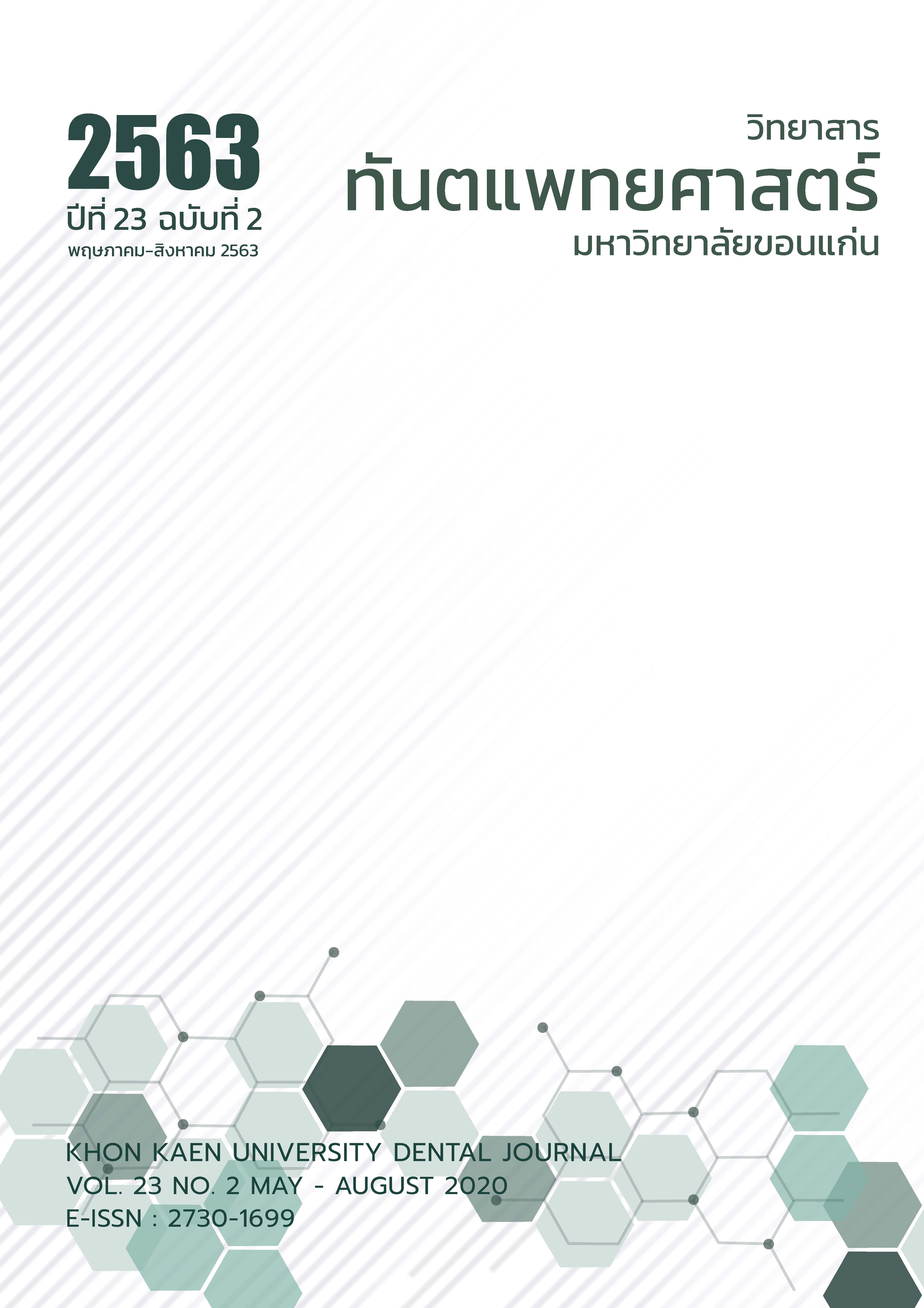Comparison of Debris Extrusion, Completeness of Removal and Operation Time in Different Rotational Speed of Root Canal Filling Removal by XP-endo Finisher R File
Main Article Content
Abstract
The aim of this study was performance of different rotational speed of XP-endo finisher R for root canal filling removal on mandibular premolar regarding the amount of debris extrusion, completeness of removal and operation time. Thirty-six extracted human mandibular premolars were prepared and filled. Then, the root canal filling was first removed with pilot file system until reached the working length. After that, samples were divided into three groups according to the speed of XP-endo Finisher R, 800, 900, 1,000 rpm, respectively. During root canal filling removal, vial was used to collect apically extruded debris. The radiographs before and after using of XP-endo Finisher R were taken and compared for evaluating the completeness of root canal filling removal while operating time for root canal filling removal was record. Statistical analysis was performed by using Kruskal-Wallis test with statistical significance level at 0.05. Debris extrusion and root canal cleanliness were not different among the 3 groups. However, there was a statistically significant difference regarding the operating time. Rotational speed at 1,000 rpm demonstrated less operation time than 800 rpm. In conclusions, Different rotational speed of XP-endo finisher R did not influence Debris extrusion and root canal cleanliness. During retreatment, at 1,000 rpm rotational speed use less operation time than 800 rpm.
Article Details
บทความ ข้อมูล เนื้อหา รูปภาพ ฯลฯ ที่ได้รับการลงตีพิมพ์ในวิทยาสารทันตแพทยศาสตร์ มหาวิทยาลัยขอนแก่นถือเป็นลิขสิทธิ์เฉพาะของคณะทันตแพทยศาสตร์ มหาวิทยาลัยขอนแก่น หากบุคคลหรือหน่วยงานใดต้องการนำทั้งหมดหรือส่วนหนึ่งส่วนใดไปเผยแพร่ต่อหรือเพื่อกระทำการใด ๆ จะต้องได้รับอนุญาตเป็นลายลักษณ์อักษร จากคณะทันตแพทยศาสตร์ มหาวิทยาลัยขอนแก่นก่อนเท่านั้น
References
Hülsmann M, Peters OA, Dummer PM. Mechanical preparation of root canals: shaping goals, techniques and means. Endod Topics 2005;10(1):30-76.
Seltzer S, Naidorf IJ. Flare-ups in endodontics: I. Etiological factors. 1985. J Endod 2004;30(7):476-81.
Madhusudhana K, Mathew VB, Reddy NM. Apical extrusion of debris and irrigants using hand and three rotary instrumentation systems - An in vitro study. Contemp Clin Dent 2010;1(4):234-6.
Siqueira JF, Jr. Microbial causes of endodontic flare-ups. Int Endod J 2003;36(7):453-63.
Imura N, Kato AS, Hata GI, Uemura M, Toda T, Weine F. A comparison of the relative efficacies of four hand and rotary instrumentation techniques during endodontic retreatment. Int Endod J 2000;33(4):361-6.
Ersev H, Yilmaz B, Dincol ME, Daglaroglu R. The efficacy of ProTaper Universal rotary retreatment instrumentation to remove single gutta-percha cones cemented with several endodontic sealers. Int Endod J 2012;45(8):756-62.
Gergi R, Sabbagh C. Effectiveness of two nickel-titanium rotary instruments and a hand file for removing gutta-percha in severely curved root canals during retreatment: an ex vivo study. Int Endod J 2007;40(7): 532-7.
Lu Y, Wang R, Zhang L, Li HL, Zheng QH, Zhou XD, et al. Apically extruded debris and irrigant with two Ni-Ti systems and hand files when removing root fillings: a laboratory study. Int Endod J 2013;46(12):1125-30.
Topcuoglu HS, Akti A, Tuncay O, Dincer AN, Duzgun S, Topcuoglu G. Evaluation of debris extruded apically during the removal of root canal filling material using ProTaper, D-RaCe, and R-Endo rotary nickel-titanium retreatment instruments and hand files. J Endod 2014;40(12):2066-9.
Canakci BC, Ustun Y, Er O, Genc Sen O. Evaluation of Apically Extruded Debris from Curved Root Canal Filling Removal Using 5 Nickel-Titanium Systems. J Endod 2016;42(7):1101-4.
Giuliani V, Cocchetti R, Pagavino G. Efficacy of ProTaper universal retreatment files in removing filling materials during root canal retreatment. J Endod 2008;34(11):1381-4.
Barrieshi-Nusair KM. Gutta-percha retreatment: effectiveness of nickel-titanium rotary instruments versus stainless steel hand files. J Endod 2002;28(6):454-6.
Shivanand S, Patil CR, Thangala V, Kumar PR, Sachdeva J, Krishna A. To evaluate and compare the efficacy, cleaning ability of hand and two rotary systems in root canal retreatment. J Contemp Dent Pract 2013;14(3):440-4.
Rodig T, Hausdorfer T, Konietschke F, Dullin C, Hahn W, Hulsmann M. Efficacy of D-RaCe and ProTaper Universal Retreatment NiTi instruments and hand files in removing gutta-percha from curved root canals - a micro-computed tomography study. Int Endod J 2012;45(6):580-9.
Bramante CM, Betti LV. Efficacy of Quantec rotary instruments for gutta-percha removal. Int Endod J 2000;33(5):463-7.
Kfir A, Moza-Levi R, Herteanu M, Weissman A, Wigler R. Apical extrusion of debris during the preparation of oval root canals: a comparative study between a full-sequence SAF system and a rotary file system supplemented by XP-endo finisher file. Clin Oral Invest 2018;22(2):707-13.
Alzuabi MA AR. Ability of XP- Endo Finisher and XP-Endo Finisher-R in Removal of debris from the root canal walls after Retreatment An In-Vitro Study. Int Arab J Dent 2018;9(2):60-4.
Myers GL, Montgomery S. A comparison of weights of debris extruded apically by conventional filing and Canal Master techniques. J Endod 1991;17(6):275-9.
Turker SA, Uzunoglu E, Saglam BC. Evaluation of the amount of apically extruded debris during retreatment of root canals filled by different obturation techniques. Niger J of Clin Pract 2015;18(6):802-6.
Liu M, Xiong S, Tan F, Liu Y. Less extrusion debris during the retreatment of curved canals using twisted files with higher rotational speeds: an ex vivo study. BMC Oral Health 2017;17(1):45.
Hashemi M, Mackevic M. Efficacy of maxwire® alloy file in removing the remains of root canal filling material in vitro. Sveikatos mokslai/Health Sciences 2018;28(2):46-51.
Webber M, Piasecki L, Jussiani EI, Andrello AC, Dos Reis PJ, Azim KA, et al. Higher Speed and No Glide Path: A New Protocol to Increase the Efficiency of XP Shaper in Curved Canals-An In Vitro Study. J Endod 2020;46(1):103-9.


